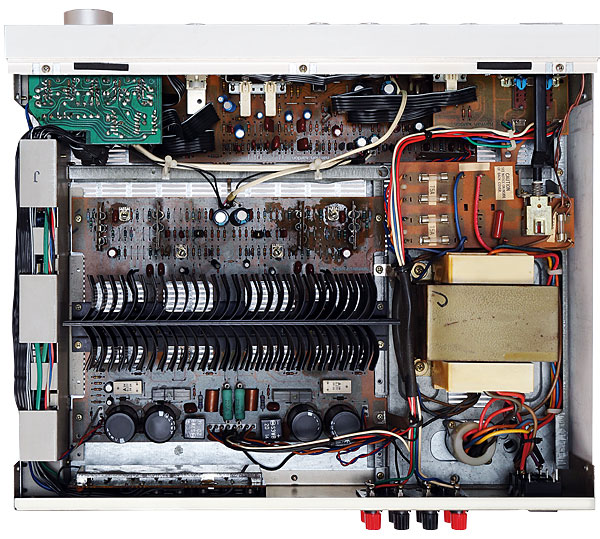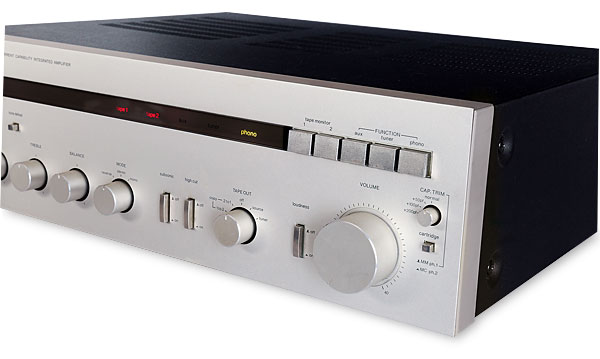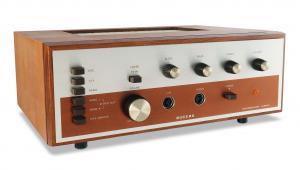Harman Kardon PM650 Page 2
Simple Set-Up
Despite being a nearly 40-year-old design the Harman Kardon PM650 doesn't feel particularly 'vintage'. The styling is still fresh and there isn't anything missing from the feature list – in fact it's perhaps a bit too generous for modern tastes! Things such as a built-in phono stage, tone controls (which can be bypassed if desired) and a headphone socket are no longer standard fare, but the PM650 has the lot.
Set-up is therefore simplicity itself as modern cables fit into the sockets and modern sources still match the input sensitivities. Operationally too there is little difference between the PM650 and a quality modern amplifier, the controls are all instantly familiar and there are no ergonomic quirks to battle with.

Although the purists may sneer, I found the PM650's tone controls to be particularly well thought out and useful. Both the turnover frequencies and operating ranges are well chosen, making the controls easy to use for simple loudspeaker/room interface corrections and for the rebalancing of less than ideal recordings. The loudness compensation arrangements were less successful, there being little influence at the lowest settings of the volume control where, arguably, the effect is of the greatest value.
![]() Tim Listens
Tim Listens
The PM650 is a book that can easily be judged by its cover. It's a big amp with a big sound, and there's nothing effete or delicate about it. Fifty watts isn't an especially large figure, but the sound does not even begin to approach chaos until the volume is very, very loud indeed.
The design's overall tonal balance is difficult to pigeonhole. It appears to have a slightly soft top end, but that could well be a result of the copious amounts of bass power it generates. That's not to say the sound is thick and ponderous but neither is there a tendency towards the 'lean' sound some amplifiers exhibit. I noticed that the PM650 became more fluid and natural-sounding the louder it was played. Yes, the presentation was enjoyable at low volumes, but it improved noticeably every time the volume knob was advanced clockwise.
The usefulness of this characteristic depends largely on your listening habits. If you like to relax to chamber music well into the small hours then this is probably not the optimal amplifier for your system. However, if you relish the opportunity to 'rock out' the moment the house is empty then the PM650 is required listening and (probably) an essential purchase.
Life Enhancing
Of course, this amp isn't just about making a lot of noise. The PM650 shares all the usual virtues of a well developed DC-coupled Japanese amplifier, such as the ability to produce a solid, widely spread soundstage and an essentially silent background between tracks. Level 42's World Machine [Polydor 827 487-2] is an album to enjoy when a robust-sounding amplifier is available as anything too weedy will make it sound bright, strident and hard. Putting the weight of the PM650 behind tracks such as 'Physical Presence' and 'Dream Crazy' really brought them to life in a way other amplifiers with higher headline ratings cannot always manage. Again a marginally soft tonal balance was noted, but at no point was this sufficient to dull the treble sparkle in the percussion.
Big orchestral pieces also benefited from the PM650's muscle and its ability to produce a near silent background, even when the volume control was well advanced. The overture to Rossini's La Gazza Ladra conducted by Claudio Abbado [Deutsche Grammophon 431 653-2] was thrillingly vibrant when played at realistic levels through the PM650. If there was a shortcoming it was that the amp's slightly muted treble tended to rob the music of some of its immediacy. To be surrounded by and immersed in this much sound did make for a realistic concert experience though, which is surely what hi-fi is all about.

Key Trade-Off
So what happens when you don't thrash it? Playing the stereo 16-bit layer of the 2002 SACD release of Diana Krall's album The Look Of Love [Verve 314 589 597-2] revealed a subtle veiling of vocal texture as the key trade-off against having all that power available. With material like this the PM650's character came across as fairly neutral, although some coloration in the upper registers was still evident.
Overall this is an easy amplifier to live with, being complete in facility terms and easy to listen to even in extended sessions. It isn't really a collector's piece, but as a component to be used every day it has a lot to recommend it, though your neighbours may not agree.
Buying Secondhand
Large, powerful amplifiers can often prove more troublesome in their later lives than their more modest counterparts, but the PM650 lies just on the right side of the line.
Build quality was not at the Sony/Pioneer/Technics level so a well used example will probably look scruffy by now, and the slightly roughened fascia is difficult to clean once it gets marked or dirty. Internally, the main source of trouble is the quality of the soldering which can lead to all manner of intermittent problems. The legs of some of the transistor types used were too small for the holes in the PCB they went through, causing problems for the automatic soldering machines in the factory. Blanket re-soldering is sometimes the only cure.
There are a lot of switch contacts in the PM650 too and erratic operation can occur as they tarnish with age. A carefully applied dose of a suitable contact cleaner will usually solve this problem though.

Hi-Fi News Verdict
High current amplifiers may not have caught the public's imagination, but the PM650 shows that there may be some validity in the idea. This is a comprehensively equipped integrated that works well in most respects, is well made and which still looks good. Playing loud is its forte, so if you are seeking an amp able to deliver on that score then this is a model worthy of your attention.























































